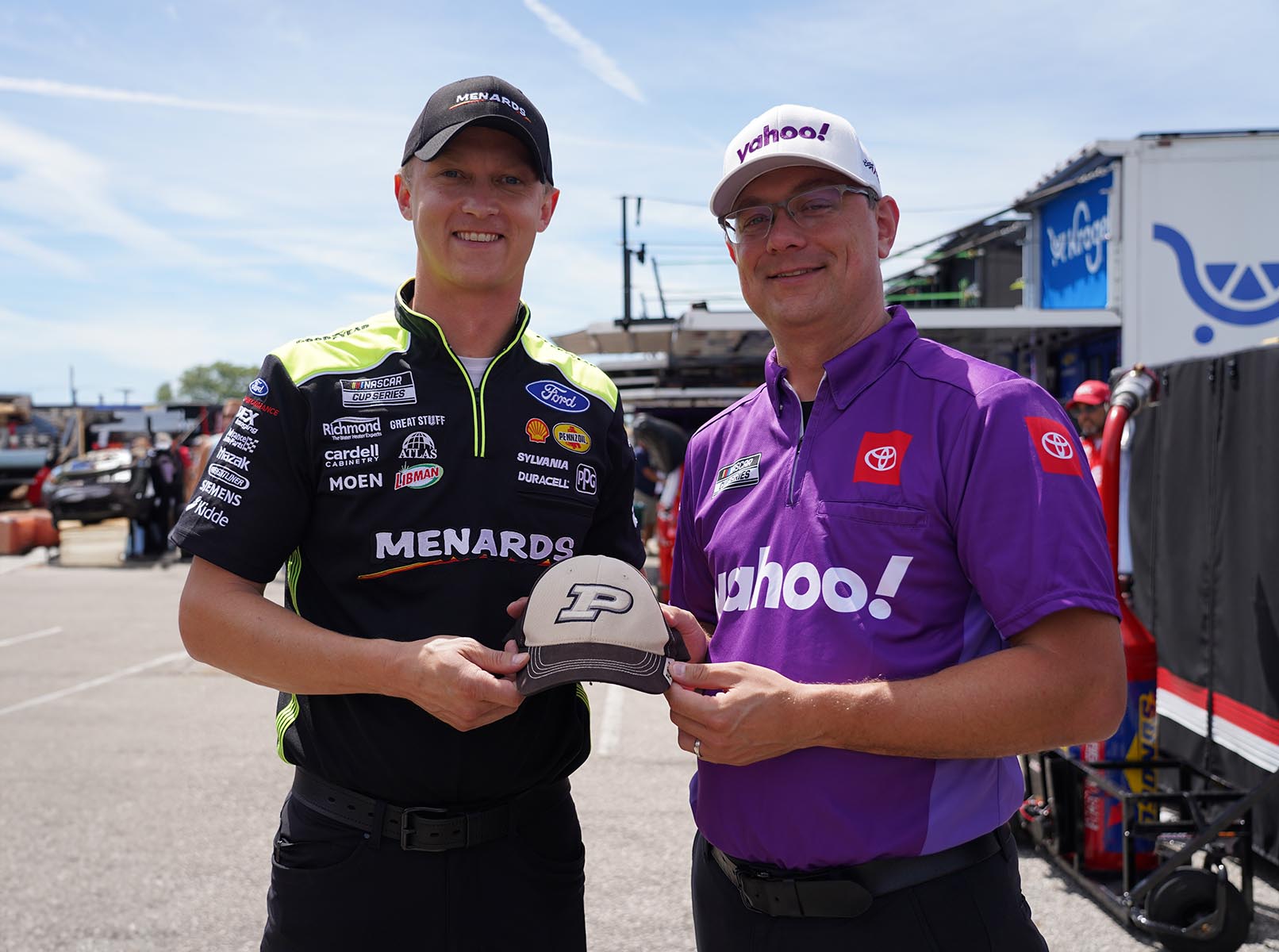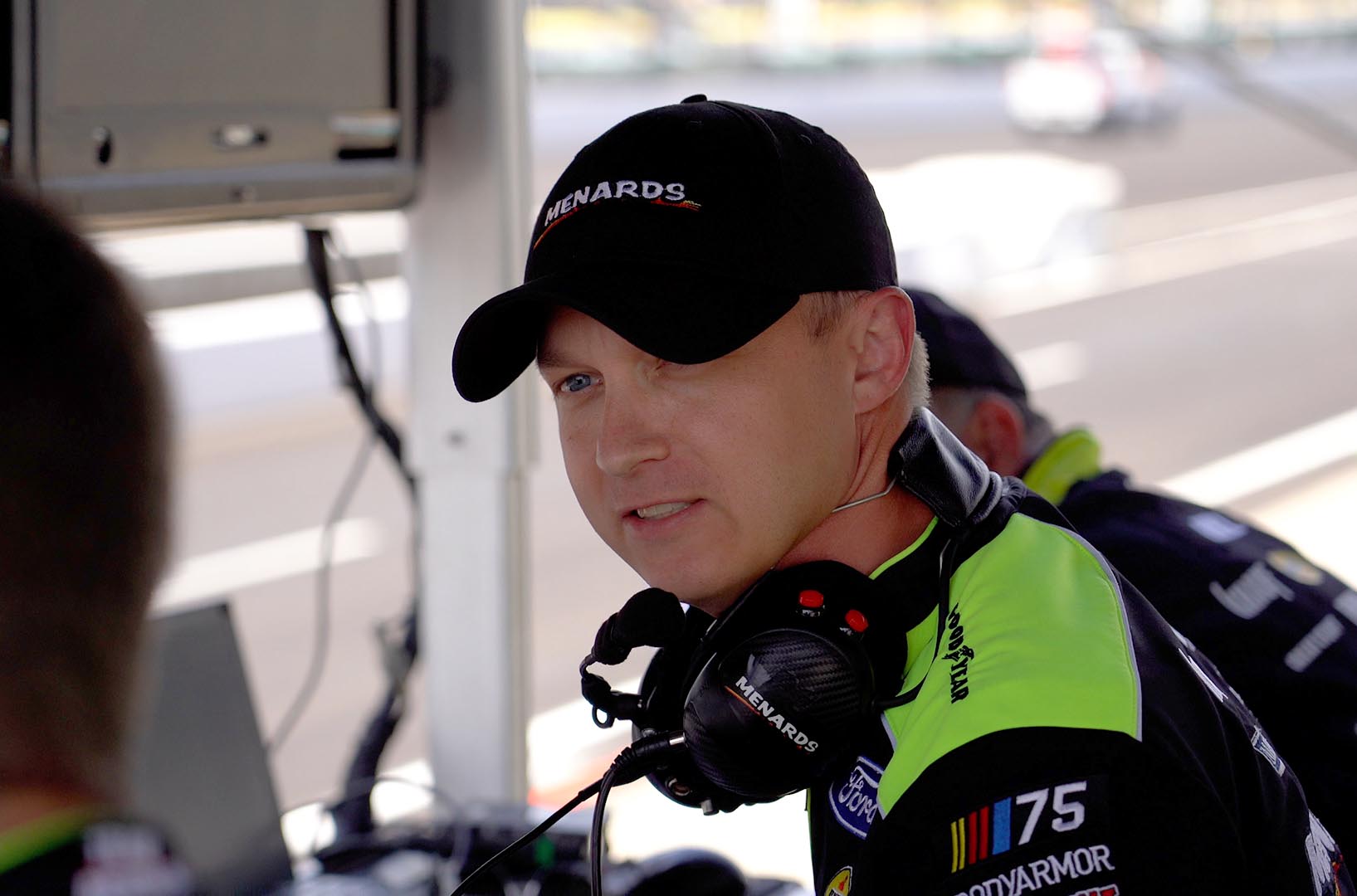Jonathan Hassler races to success as a NASCAR crew chief
Brickyard weekend at Indianapolis Motor Speedway is probably the most hectic 48 hours in motorsports. The top three American racing series all compete back-to-back – which means that pit lane has three times more people than usual. Fans everywhere are taking selfies and hounding their favorite drivers for autographs. Crew members are trying to weave tire carts through the huge crowds. Course marshals are blowing their safety whistles. Celebrities are giving interviews in front of camera crews, while surrounded by fans, sponsors, and general hangers-on. One supporter literally fist-bumps a stack of tires belonging to his favorite driver.
Into this chaos steps Jonathan Hassler (BSME ’07), crew chief for NASCAR's #12 Team Penske driver Ryan Blaney.
His entrance goes unnoticed, without even a single autograph request. And that’s the way he prefers it. While most fans will be paying attention to the person behind the wheel, it’s actually the 3-ring binder in Hassler’s right hand which may be the difference between his team finishing mid-pack, or taking the checkered flag.
Saturday night special
“When I was 8 years old, my dad first took me out to the go-kart track,” said Hassler, a native of Greencastle, Indiana. “A week later, he bought me my own kart, and that was it. I’ve been in racing ever since.”
He remembers his whole family racing on Saturday nights, running five or six different karts. One by one they all left the hobby – but not Jonathan. “I was about 13 when I decided I really wanted to make a career out of this,” he said. “My family supported me, and we travelled to different tracks around the country.”
Even then, the seeds of a crew chief’s life were evident. “I made sure all of our equipment was maintained properly,” he remembered. “I did everything I could to maximize my performance. I spent hours reading forums on the Internet just to try to get better.”
One of the people he met in those early online karting forums was Chris Gabehart, who had won several national championships in karting. Gabehart had pursued an engineering degree at Purdue University, following the footsteps of NASCAR driver Ryan Newman. This sealed the deal for Hassler. “I knew the size of Purdue and the number of networking opportunities was something that would pay dividends in the long run,” he said. “And it definitely has.”

Land of opportunity
As a first-year engineering student at Purdue, Hassler faced the same challenges as everyone else: making friends, studying for exams, working hard to pass Prof. John Starkey’s Vehicle Dynamics class. But he saw the opportunity for something more.
“I knew there were a lot of people like me at Purdue who had a passion for motorsports,” said Hassler. “But they might not have the connections or avenues for advancement to build a career out of it. So we started our own group called Opportunity Motorsports.”
Hassler and his fellow students offered their services to local race teams at small events throughout the Midwest. They volunteered to work with Gabehart, who had since graduated and become a driver in the CRA Super Series. That led to other connections in the late-model racing world, and an expanded race calendar for Opportunity Motorsports. Even if they weren’t racing on a particular weekend, Hassler and his fellow students would go to a team’s garage and hang out, helping to get their cars ready for the next race. “I remember leaving school on a Thursday and driving to a track somewhere in Kansas,” he said. “My Honda Civic ran out of gas on the interstate in the middle of the night, and we had to push it about half a mile to a gas station!”
One of Hassler’s most notable volunteers was Angela (McCallum) Ashmore – who eventually worked her way to success in both NASCAR and IndyCar, becoming the first female crew member to win the Indianapolis 500. “The goal was to give engineering students the opportunity to get their foot in the door,” said Hassler. “A lot of my classmates were able to get great jobs in motorsports and have a lot of success. So I’m certainly proud of what we were able to achieve.”

The main feature
Spring break of his junior year, Hassler and some of his Opportunity teammates drove down to Charlotte, North Carolina, and as he describes it, “started knocking on doors.” With a majority of NASCAR teams headquartered nearby, Hassler had hoped to impress at least one of the shops into giving him a chance. Eventually he joined MB2 Motorsports as an intern, where he got his first taste of contributing in the NASCAR world. Then, the day after he graduated from Purdue, he got the phone call from Team Penske.
“I was hired as a race engineer straight out of school, which is a big deal,” he said. “The race engineer is kind of the assistant to the crew chief, so I would provide him as much information as possible to make the right decisions on race day.”
Hassler initially worked for a NASCAR Xfinity Series team (one tier below the NASCAR Cup Series). After five years he was promoted to the Cup series, where he served in the garages of champion drivers like Kurt Busch, Brad Keselowski, and Joey Logano.
During the 2021 season, an interesting opportunity came his way. The crew chief for driver Matt DiBenedetto (of the Penske-affiliated Wood Brothers team) was unavailable, and Hassler was asked to fill in. So what was it like, sitting in the “big chair” for the first time? “Everyone here is standing on someone else’s shoulders,” he said. “There is always someone in your headset who can talk you through the whole thing. But you find out quickly whether or not you can do it on your own. That’s when I realized that I could definitely do the job, and more importantly, I wanted to do the job.”
He would soon get his chance. DiBenedetto’s full-time crew chief was let go halfway through the season, and Jonathan Hassler came on board for the remaining 2021 races. While they missed the playoffs, the team had several shining moments – and Hassler showed that he had what it takes to succeed at the highest level.
Then, DiBenedetto was let go. “That offseason was certainly an interesting time for me,” said Hassler. “But the stars ended up aligning with Ryan Blaney, as his previous crew chief had retired. Ryan and I are friends outside the track, so we met and talked things over. We knew we wanted to work together and see what we could do.”

Success for Blaney and Hassler came slowly. Their only win in 2022 came at the exhibition All-Star Race – and even then, there was controversy. After crossing the finish line, Blaney had let down his window net to celebrate, without realizing that NASCAR had thrown a yellow flag and added additional laps to the race. By the letter of the law, Blaney should have been disqualified, with Denny Hamlin’s #11 car winning instead. But being an exhibition, NASCAR allowed Blaney’s jury-rigged window net to pass, giving their team the $1 million prize. “Chris and I will be joking about that for a long time,” said Hassler.
Yes, that same Chris Gabehart – who shared go-kart tips in online forums, who endured the same Purdue mechanical engineering classes, who welcomed Jonathan’s student volunteers onto his late model team – is now the crew chief for Denny Hamlin, one of Penske’s competitors. But he also remains one of Hassler’s biggest fans. “Outside of my own team, I’m always cheering for the #12,” said Gabehart, who caught up with his former classmate during the chaos of Brickyard weekend. He added with a smile: “It’s the only team where I don’t mind running second!”
Many different hats
On race day, Hassler is well prepared. Sitting atop his pit box, his 3-ring binder has every contingency covered. But NASCAR crew chiefs actually play many different roles: engineer, manager, spokesperson, psychologist, advocate, and most importantly, decision maker. “There are a lot of different facets to the job,” he said. “You have to be engineering-minded and make the best technical data-driven decisions you can. But there’s also a big human factor to leading a team. I make sure my guys are happy in their jobs, that they have a good work-life balance. This helps us all to provide the best effort to the team.”
And then of course, there’s the driver. “I make sure he’s in the best frame-of-mind at all times,” he said. “Outside of the car, Ryan’s as cool as can be. But once he straps in, he can sometimes get overly worked up during the race. You need a little bit of that as a driver, but you can’t let it take over. That’s why I try to be calm and steady through the whole race. So we really complement each other.”
Their biggest test of 2023 came Memorial Day weekend at the Coca-Cola 600 in Charlotte – NASCAR’s longest race of the year. While many cringe at the prospect of running full throttle for nearly 5 hours, Hassler embraces it. “I joke with people that I’d run 600-mile races every weekend if I could!” he laughed. “I love the endurance part of it – the mental challenge, adapting to changing conditions.”
In the end, Ryan Blaney’s car finished in 1st place, winning his first regular-season race together with Hassler. “We’d definitely had an up-and-down season to that point, but we dominated that race,” said Hassler. “It’s a testament to what happens when you focus on making yourself better every week.”
One of the unique rituals of victory lane is taking multiple team photos with the car and the trophy, and swapping out individual sponsor hats for each photo. For a crew chief who is always wearing many different hats, it’s an ideal metaphor!

Hammer down
When Jonathan Hassler was a Purdue mechanical engineering student, he felt the need to forge his own path to a motorsports career. Today, those opportunities are more abundant than ever:
- Purdue’s student racing organizations demonstrate consistent success. Last year, Purdue’s Formula SAE team finished second in the world.
- Purdue University in Indianapolis hosts the only accredited motorsports engineering program in the country.
- The EV Grand Prix uses electric go-karts to get students involved in engineering through motorsports, even at the high school level.
- Purdue students and alumni fill the rosters of motorsports series around the world: Angela Ashmore with Chip Ganassi Racing; Bill Pappas with IndyCar; Kayli Peterson in NASCAR Super Late Model; Nathan O’Rourke with Andretti Autosport; Matt Keubel with Penske’s IndyCar team; Zach Nelson with Juncos Hollinger Racing; and more students interning in race shops every summer.
Hassler is not surprised to see so many of his fellow Boilermakers in the upper echelons of motorsport. “Purdue has so many resources to draw from,” he said. “Anything in the world is possible, if you have the right people in place. After that, the sky is the limit.”

Writer: Jared Pike, jaredpike@purdue.edu, 765-496-0374
